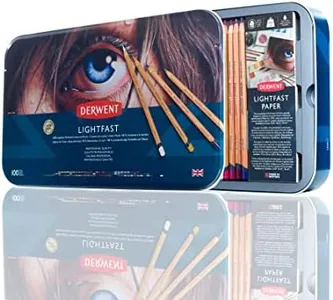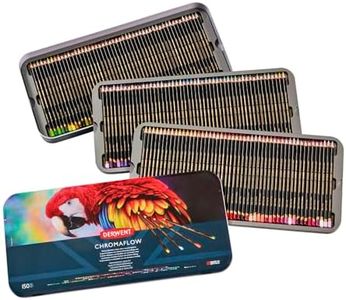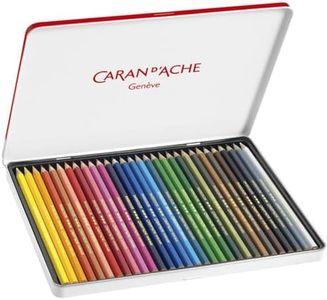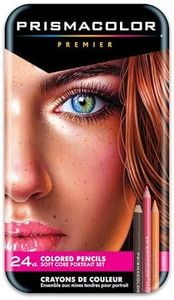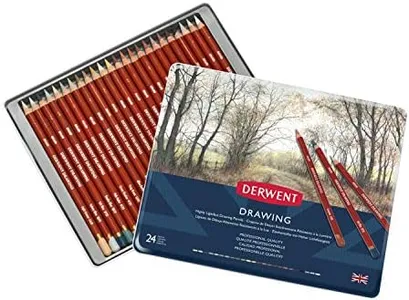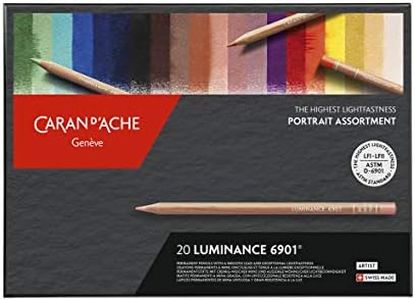We Use CookiesWe use cookies to enhance the security, performance,
functionality and for analytical and promotional activities. By continuing to browse this site you
are agreeing to our privacy policy
10 Best Oil Coloring Pencils
From leading brands and best sellers available on the web.By clicking on a link to a third party's website, log data is shared with that third party.
Buying Guide for the Best Oil Coloring Pencils
Choosing oil coloring pencils can be an exciting process since these tools are popular among artists and hobbyists for their rich pigments and unique blending abilities. The main goal is to find pencils that fit your style, meet your needs for color vibrancy, and are comfortable to use. Consider what kind of art you want to create, how often you plan to use them, and whether you need professional quality or something for practice and doodling. Paying attention to a few key specifications will help you select the set that's just right for you.Core Type and HardnessThe core of oil coloring pencils is the colored material inside, which contains a mix of pigment, oil, and sometimes wax. Hardness refers to how soft or hard the core feels when drawing. Softer cores produce richer color and are easier to blend, making them great for creating smooth gradients and layering colors. Harder cores keep their point longer and are better for detailed work or fine lines. If you like to blend and create vivid art, choose softer cores. For detailed, precise illustrations, go for medium or harder cores.
Color RangeColor range is the total number of distinct colors included in a set. A wide color range gives more options for shading, blending, and creating subtle variations, which is essential for detailed or realistic artwork. Smaller sets with basic colors are suitable for beginners or casual use, while large sets with many shades are perfect for experienced artists who want nuanced control. Think about the types of drawings you plan to make and whether you prefer a few versatile colors or a wider selection.
LightfastnessLightfastness is a measure of how well the colors resist fading when exposed to light over time. High lightfastness means the colors will stay vibrant much longer, which is important if you want your artwork to last for years or if you plan to display or sell it. Sets with lower lightfastness are often fine for practice or temporary projects. Artists who want their work to remain unchanged should look for pencils with a lightfastness rating provided on the packaging.
BlendabilityBlendability describes how easily the pencil colors mix with each other when layered or blended using tools like blenders, paper stumps, or even your finger. Oil-based pencils generally blend very well, producing soft transitions and rich hues. For smooth, painterly effects, choose pencils that are known for easy blending. If you want crisper lines or minimal color mixing, a less blendable pencil might suit you better.
Barrel Shape and SizeThe barrel is the outer casing of the pencil, which can vary in shape (round, hexagonal, or triangular) and thickness. The shape affects comfort and grip, especially during long drawing sessions. Hexagonal or triangular barrels can help prevent the pencil from rolling off your desk and can feel more secure in hand. Thicker barrels may be easier to hold for some, especially those with larger hands or grip issues. Try holding different shapes if possible to see which feels best for you.
Layering CapabilityLayering capability refers to how many times you can add new layers of color over previous ones without smudging or losing vibrancy. Oil coloring pencils that allow for extensive layering are ideal if you want to build up rich, complex effects in your artwork. If you like simple drawings with minimal layering, this spec may not be as crucial. Artists who work in many layers or want depth in their work should prioritize pencils that handle layering well.
Ease of SharpeningEase of sharpening considers how well the pencil withstands frequent sharpening without breaking and whether it easily maintains a sharp, fine point. Pencils with strong cores and quality barrels are less likely to splinter or snap when sharpened. If you do lots of detail work or need sharp points, look for pencils known for their easy sharpening. If you mostly work with broader strokes, this may not be as important.

